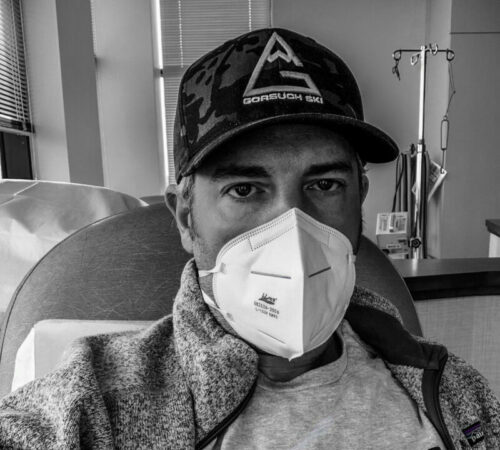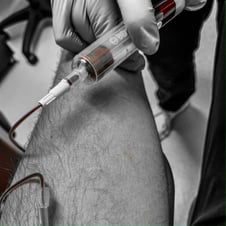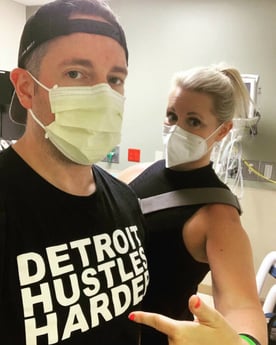Testicular Cancer Leads Physician to Focus on Priorities, Not ‘All the Noise’
4 min read

In honor of Testicular Cancer Awareness Month, Dr. Michael Gallizzi, MD, MS, FAAOS, of Denver, Colorado, wants everyone to learn one new thing: “Know that there are different types of testicular cancer. If you think something is abnormal, get it checked. We always hear ‘watch for lumps and bumps,’ but mine absolutely wasn’t a lump or bump.”
Dr. Gallizzi is speaking as a cancer survivor – not as a physician. A Minimally Invasive Spine Surgeon at Sky Ridge Medical Center, Dr. Gallizzi’s knowledge of testicular cancer was purely academic until the age of 39. At that point, he noticed one testicle was larger than the other. However, he had been diagnosed with low testosterone five years earlier, and the medication for it can cause a testicle to shrink. “So, I couldn’t tell if it was bigger or if one had shrunk. It felt smooth, so it wasn’t 100% clear to me that it was cancer.”
Another physician friend recommended he see a urologist, who agreed the smoothness made it difficult to identify the problem. But an ultrasound indicated a solid mass inside his testicle. Subsequent tests showed the mass to be cancerous but not malignant, a type of cancer known as smooth-type seminoma. This cancer causes the testicle to shrink, and the tumor essentially replaces it. Since it’s not a mass growing on the testicle, it does not result in the “lumps and bumps” that are the more common symptoms of testicular cancer.
 A week later, the surgeon was being operated on. The surgery to remove Dr. Gallizzi’s cancerous testicle entailed an incision in his abdomen and the removal of the tumor, testicle, lymph nodes, and any other places where cancer cells could be hiding. At Rocky Mountain Cancer Centers, Dr. Gallizzi received one “megadose” of chemotherapy through an IV infusion, which was required because of the tumor’s large size.
A week later, the surgeon was being operated on. The surgery to remove Dr. Gallizzi’s cancerous testicle entailed an incision in his abdomen and the removal of the tumor, testicle, lymph nodes, and any other places where cancer cells could be hiding. At Rocky Mountain Cancer Centers, Dr. Gallizzi received one “megadose” of chemotherapy through an IV infusion, which was required because of the tumor’s large size.
Following the surgery, and later chemotherapy, Dr. Gallizzi took very little time off work, which he acknowledges was not good for his recovery.
“I tell people to take care of themselves, which is pretty much the opposite of what I did,” he said. “I really encourage my spine surgery patients to focus on recovery and forget about the obligations they think they have. That was a really hard balance for me, but if someone has that ability, I encourage them to take time to process, to de-stress their life, to recover. Focus on your priorities and forget all the noise.”
 Being immunocompromised during the time of COVID and treating vulnerable patients, Dr. Gallizzi (and his wife) spent many months restricting their social interactions.
Being immunocompromised during the time of COVID and treating vulnerable patients, Dr. Gallizzi (and his wife) spent many months restricting their social interactions.
“I had a responsibility to myself to not get sick and a responsibility to my patients to not get sick,” he said. “It was a very lonely time.”
Though testicular cancer has a very high treatment success rate, Dr. Gallizzi says each appointment for ongoing monitoring is intense and nerve-wracking.
“I think everybody has a lot of anxiety in the checkups because you never know,” he said. “The anxiety is tremendous; the unknown.”
Facing the unknown (and the anxiety that often accompanies it) has compelled Dr. Gallizzi to make his own self-care more of a priority.
“That’s one thing I took away from all this – taking more time to take care of myself a little better, more time to process,” he said.
“Keep positive people around you, get rid of negative people. I’m super lucky to have such an amazing, supportive wife and support system. One of the really cool things my wife did was during the week I took off after surgery, she took us out to Gateway and it was during the Neowise Comet.”
 Gateway, Colorado, is in the desert with stunningly clear views of the night sky. Meanwhile, Dr. Gallizzi, who is a talented photographer, captured some of the most incredible images of the comet imaginable. They’re the kinds of images that professional photographers travel the world to get. The kinds of images that leave the viewer in awe of the cosmos, feeling simultaneously powerful and insignificant.
Gateway, Colorado, is in the desert with stunningly clear views of the night sky. Meanwhile, Dr. Gallizzi, who is a talented photographer, captured some of the most incredible images of the comet imaginable. They’re the kinds of images that professional photographers travel the world to get. The kinds of images that leave the viewer in awe of the cosmos, feeling simultaneously powerful and insignificant.
“I think we collect some baggage through our lives, and life-changing events help you clean that up,” Dr. Gallizzi said.
What Can You do for Testicular Cancer Awareness Month?
- Make sure you’re getting a testicular cancer screening on a yearly basis, usually at an annual checkup. If you’re due soon – or running behind – now is the perfect time to schedule. (If you don’t have testicles, now is a good time to remind the men you love to schedule their checkup!)
- If you have risk factors, consider additional preventative screening. Some risk factors for testicular cancer include: an undescended testicle, a family history of testicular cancer or HIV infection.
- Make a donation to an organization that supports testicular cancer research or survivors.
- Know the symptoms of testicular cancer:
- A lump or enlargement in one testicle.
- Fluid in the scrotum.
- Pain or discomfort in a testicle or the scrotum.
- A feeling of heaviness in the scrotum.
- Enlargement or tenderness of the breasts.
- A dull ache in the abdomen or groin.